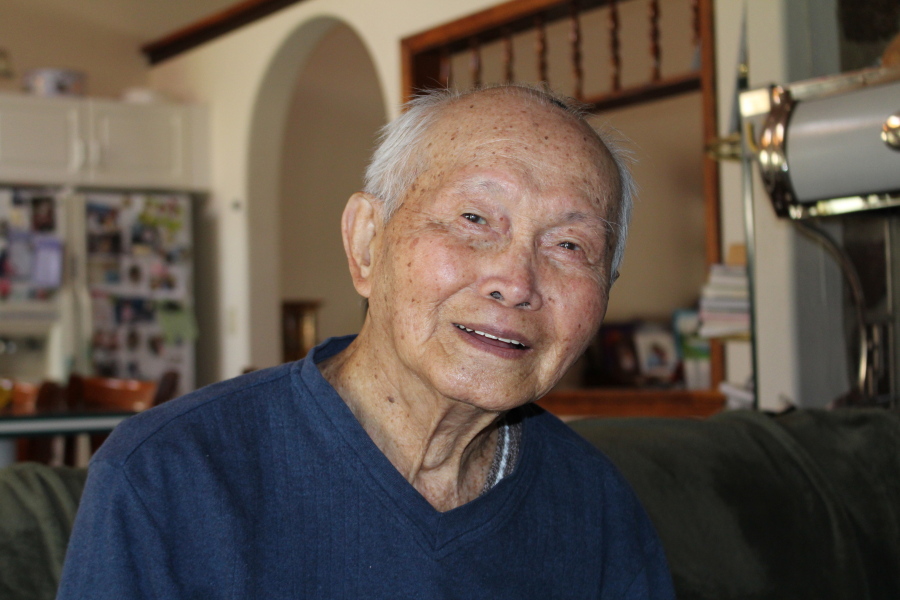MOSES LAKE — Cesar Mijares is a genuine American hero. Although he disputes that. “Never mind hero,” he said.
OK — except that Cesar Mijares, who’s going to be 98 years of age soon, fought in the first desperate campaigns of World War II in the Pacific, survived the brutal Bataan Death March and an equally brutal captivity. Once he was released it took him a year to recover – and once he was well and went home to the Philippine island of Negros, he joined the resistance army fighting the Japanese.
Mijares lives in Seattle, but he’s a frequent visitor at the Moses Lake home of his daughter and son-in-law, Babette and David Sparks, the Columbia Basin Herald reported.
Mijares was one of millions of young men all around the world whose lives went in a far different direction than they planned. He was 23 years of age, a brand-new college graduate, and planned a career in banking, he said. But there was a lot going on in the world in 1941, and it was about to affect the Philippines.
He went home for a vacation before looking for a job, and got a draft notice. “I finished four years ROTC so I was commissioned third lieutenant,” he said. The Philippines were under U.S. administration, and its leaders decided it was time to beef up the country’s defense.
“We were sworn in on Sept. 1, 1941,” Mijares remembered. The Japanese attack on the Philippines, the same day as the attack on Pearl Harbor, was three months and six days away.
That wasn’t enough time to give the Philippines the defense it needed. The Japanese invaded the islands and trapped the American and Filipino soldiers on a peninsula on Luzon, the country’s main island, called Bataan. By the time the soldiers were forced to surrender on April 9, 1942, they were out of ammunition and down to one meal, a bowl of not-very-good porridge, a day, Mijares remembered.
Once the soldiers surrendered it got worse, so much worse that, three-quarters of a century later, it still moves Cesar Mijares to tears. The Filipino and American soldiers were forced to march about 60 miles without food or water and while being beaten and tortured. Some were killed where they stood.
“I don’t know how we survived. There was no food, no water.” The only water was what they could steal from muddy ditches along the roadside. Mijares had managed to keep a bottle of iodine, which he used as a disinfectant, and that’s how he avoided getting sick, he said.
He avoided illness from drinking the filthy water, but the malnutrition eventually caused him to lose his sight. “I could not see. I could not see the guy I was touching.” But another inmate at the camp poured a little water and salt on his head, and a miracle occurred, he said. “Then I could see blue sky.”
Conditions in the camp – well, they were bad. The survivors received little food and were subject to almost constant beatings and abuse. “Every day we had a procession of bodies we had to bury,” he said. “Sometimes you would wake up and find the guy next to you already dead.” The survivors were responsible for burying the dead. “We continued the burial from morning until night.”
He was eventually released along with other Filipino prisoners who were sick, and went to Manila for medical treatment. “I had beriberi, I had malaria,” and was malnourished. “I had a big stomach – I was bald,” he said. It took him a year to recover.
He went home to Negros, he said, and had been home about a month when he was contacted by a man who had ties to the resistance army, fighting the Japanese on a neighboring island. Cesar Mijares signed up, although the reprisals would’ve been severe – even fatal – if he was caught.
He wasn’t. Mijares served through the end of the war in the resistance unit – and met his wife there, who was the commander’s sister. His unit was part of the new postwar army, and he was discharged in 1946.
In the postwar era, Mijares worked for a few years as a teacher before he started a career with the Pepsi company. He came to the U.S. in 1991.



